The architectural concept of the new space is designed to create all the necessary conditions for the implementation of social and educational innovations, supporting new ways of learning, development, and collaboration.
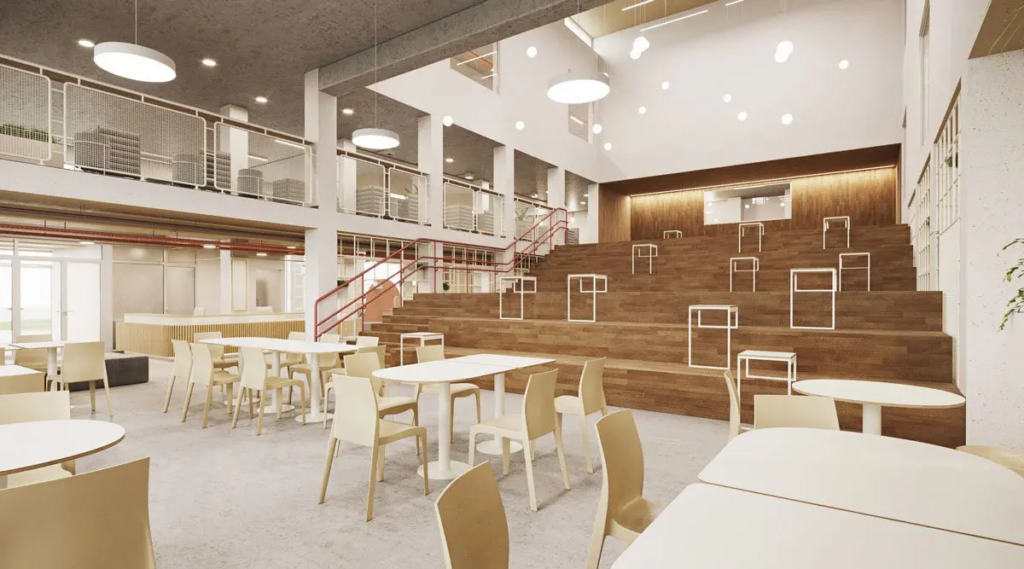
In 2015, the “Spilnoschool” opened in Kyiv, a multifunctional private educational complex with innovative approaches to general education. Soon, the school plans to move from a rented space to a specially designed facility tailored to its needs.
The architectural concept of the new space is designed to create all the necessary conditions for the implementation of social and educational innovations, supporting new ways of learning, development, and collaboration. “Skyscraper” learned about the features of the space and its creation approaches from the founder of the school, Anastasia Kyreeva, architect Yuri Kondratiuk, and Natalia Holub (representing a group of designers/architects, including Alexander Maymeskul, Daria Maistat, and Kristina Savitska).
Innovative Learning Environment
Anastasia Kyreeva, the founder of “Spilnoschool”, started thinking about the need for her own space to realize all educational ambitions from the very beginning of the project. In her opinion, today, it is necessary to create conditions for developing skills relevant to the 21st century: interaction, collaboration, self-organization, the ability to motivate oneself or focus, making choices, etc. The spaces for learning must meet these new challenges. The standard school corridor system does not suit these requirements at all.

“Since 2016, I have been researching architectural icons of new schools with open spaces. I visited schools in Denmark, Finland, the Netherlands, and Israel to see and feel how they were designed. That’s when I realized it was worth trying to implement our own project,” says the founder of the school.
Having formed a clearer idea of what the school should look like, Anastasia invited architect Yuri Kondratiuk to collaborate, who became the author of the preliminary building design.
Building Functions
The building will combine several functions. The main function will be the children’s development center, which will house the school. A kindergarten will be built nearby. If necessary, the school could also serve as a public space for cultural events or social activities with children, parents, or even entire families.
Importantly, children from other schools will be able to attend afternoon classes and studios with subscriptions. According to the founder, this expands opportunities for both “Spilnoschool” students and students from general education schools.
“We are not just creating a school. Such institutions are called Innovative Learning Environments in the English-speaking world. Children don’t just study there; they live there from morning till evening. Therefore, the space should attract and engage them during this entire time,” explains Anastasia Kyreeva.
Innovative Approaches within Old Building Norms
“Spilnoschool” is a self-sustaining project. For its creators, it was important to spend every penny efficiently. The architect’s decisions were crucial in balancing the size and quality of the premises.
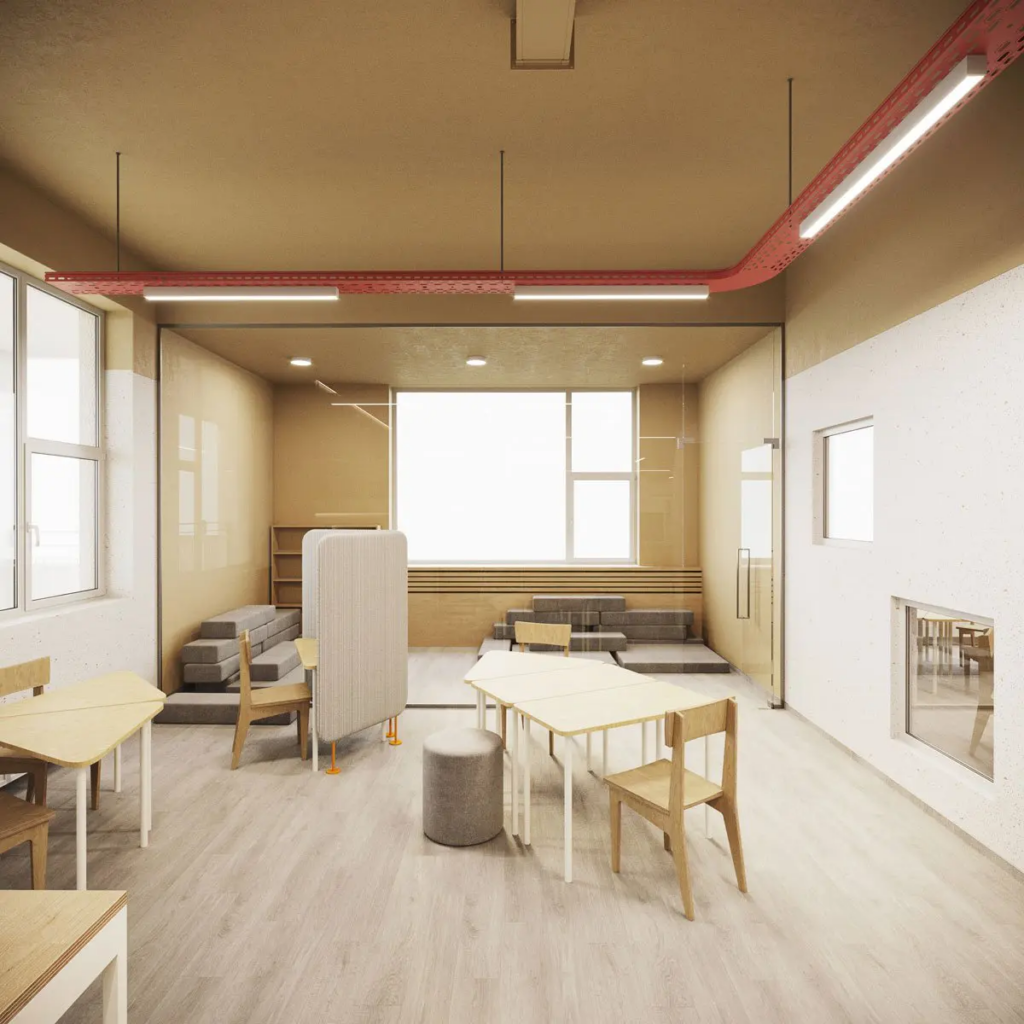
“Today, those involved in new types of learning are guided by the principles of sustainable development. In this sense, the current building standards for educational institutions are outdated. They still require huge land plots, such as for stadiums, which often end up being abandoned, separate large cafeterias, auditoriums, etc. All of this needs to be built and then maintained. Instead, we tried to optimize some elements of the space, reduce the overall project cost, and make every part of the building multifunctional,” explains the founder of the school.
The school concept is based on three main principles – multifunctionality, numerous connections between different spaces, and provoking movement.
Central Space of the School
The central element of the architectural concept was a large three-story double-height space with open balconies. However, current fire regulations did not allow for such a design. The open areas were reduced to a space with mezzanines on one side. In other areas, small walls were built.
“At first, it seemed like everything was ruined, the concept was destroyed. But eventually, we managed to use the limitations to our advantage. The space now features more stairs connecting different parts of the building,” says Natalia Holub.
“Social stairs are the main element of the school’s space, a sort of atrium where a large group of people can gather,” explains architect Yuri Kondratiuk.
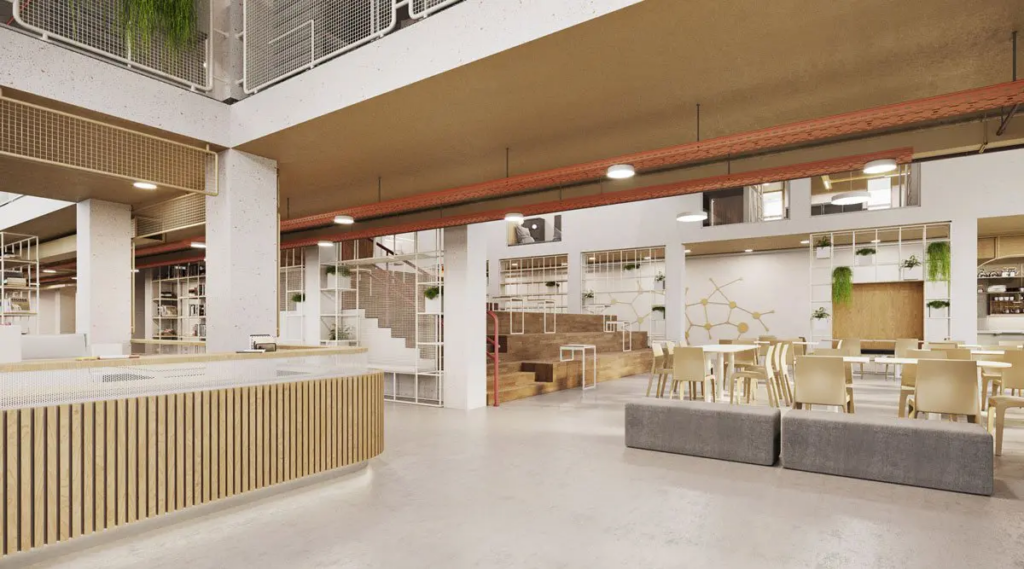
The spaces are designed to create conditions for group interaction, which is the foundation of “Spilnoschool’s” educational concept. According to the founder, teamwork is one of the important modern skills.
Open mezzanines create an additional space for teamwork, which is well visible to teachers. Those who wish to be alone can use small partitions.
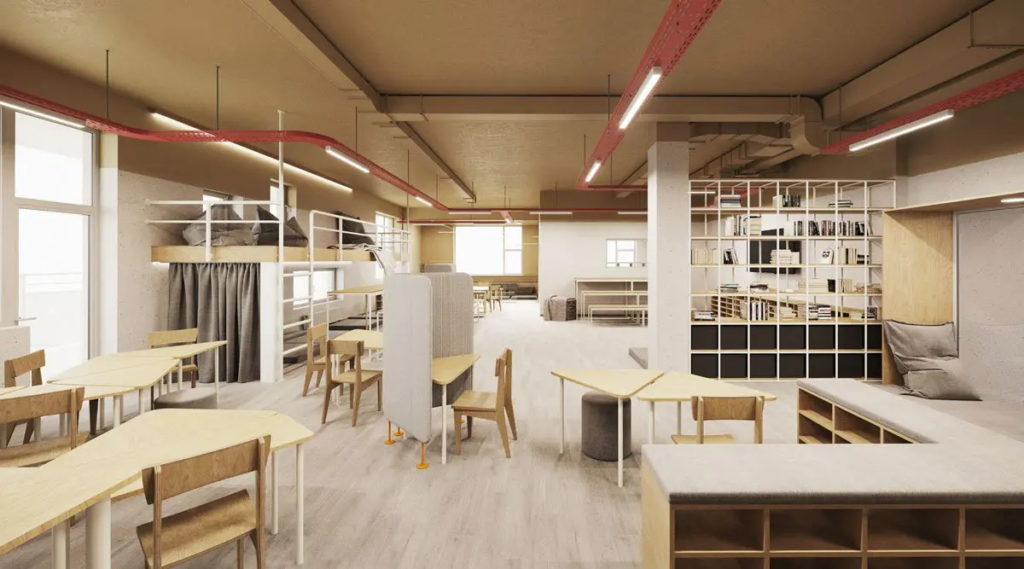
The problem of noise is one of the downsides of open-plan schools. Noise creates unconscious stress on the psyche. That’s why we found hypoallergenic acoustic carpeting, which will be placed on the stairs and mezzanine. It will act as a noise absorber,” says Anastasia Kyreeva.
For the founder of the school, it is important that children feel part of a larger whole, connected to the community, and understand from the inside how ethical principles are formed within the community to which they belong.
“House” Concept
Most of the time, children will spend in special learning environments, also known as “houses.” Each “house” is named after its age group — green (youngest), yellow, orange, red, and purple (oldest).
“In such a ‘house,’ there are about 50-70 children with a 2-3 year age difference. Along with them, there are about ten adults. This space is designed to provide the first level of engagement, closeness, comfort, attentiveness, and so on,” says the founder of the school.
The windows inside each “house” face the atrium. This creates a sense of interaction throughout the entire school, as all the most important events take place on the social stairs.
A “closed” room for 12-18 children is provided for working with a teacher or explaining new material. This space is designed for the concentration needed to absorb new information.

“The learning space must serve several functions. First and foremost, it should be academic. It should also have a sort of plaza where the entire community can gather to discuss current tasks and issues. Additionally, there needs to be space for individual activities. The space should encourage movement. Children must have a place for one-on-one conversations, which can be monitored by an adult. That’s why we have included a small ‘one-on-one’ room with a glass wall,” explains Anastasia Kyreeva.
The youngest children will also have a wet zone with access to water. This will allow them to work with their hands without leaving the “house,” which is fundamental to the learning process for younger children.
“Spilnoschool” has a long-standing tradition of gathering for “talks” — to discuss current issues, proposals, make organizational decisions, and more. For such meetings, the “houses” are equipped with small mobile amphitheaters created from mezzanines. During working hours, they can be used as tables or desks, and during local public meetings, they serve as stairs where it’s comfortable to sit with feet dangling. Additionally, the movable, mobile structure creates many opportunities for play.
Teachers also have their own “house,” which includes a small room for two people to rest. From the teachers’ room, it is also convenient to observe what is happening in the atrium. Most of the spaces in “Spilnoschool” have large windows, meaning teachers have the opportunity to monitor both educational and recreational activities from various corners.
Having designed their vision, the project authors realized that the school ultimately resembles Google offices, which accommodate many scenarios — for concentration, work, relaxation, and solitude.
Kitchen
The kitchen is an important social hub within the building. The architects aimed to create a democratic café atmosphere, where people can enjoy their time.
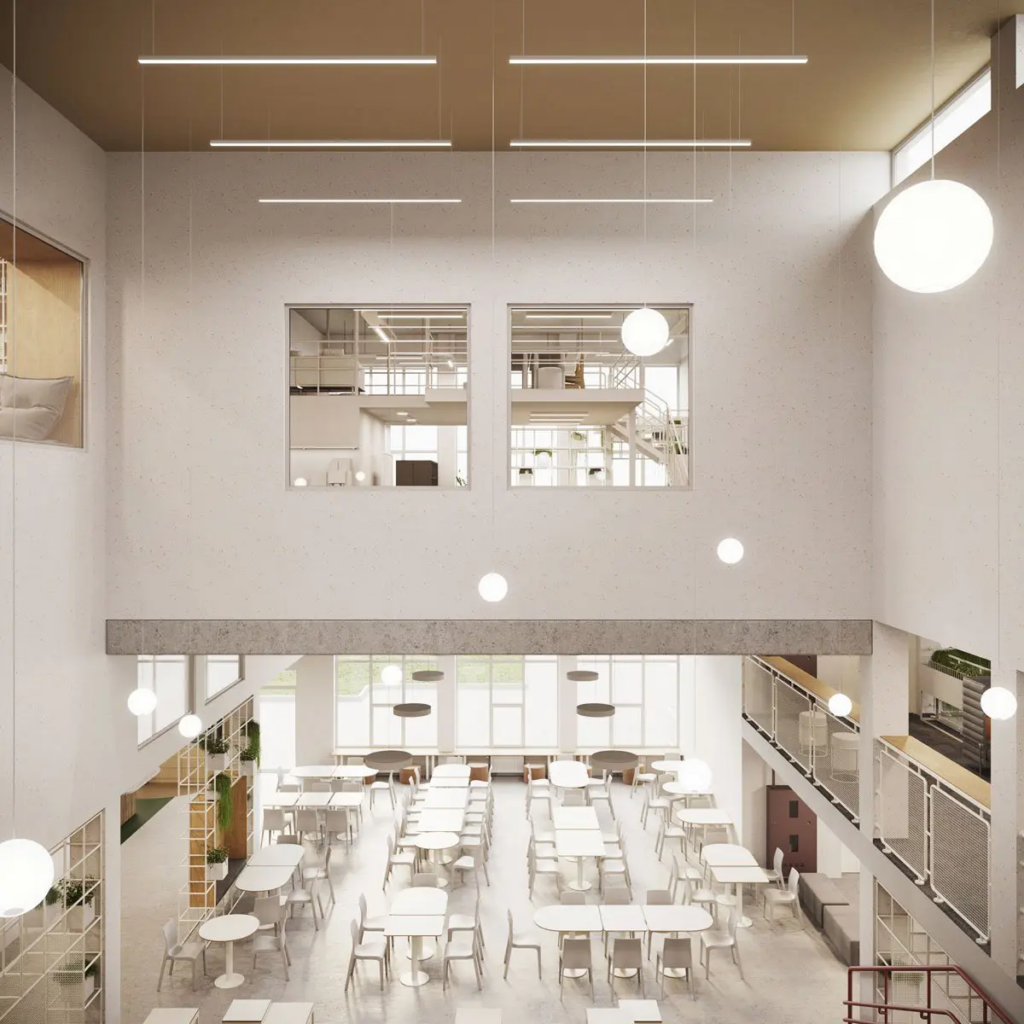
The kitchen is organized as a buffet line with options even for the youngest. A stream of people enters the room, washes their hands, takes utensils and trays, and stands in the serving line.
In the center, there is a large island where sauces, bread, snacks, and more can be placed. The island creates additional opportunities for space utilization. It can transform into a platform for workshops or a space for group activities.
Next to the kitchen, there is an exit to the street, so that in warm weather, people can enjoy lunch outdoors. Parents, while waiting for their children, can treat themselves to tea or coffee in a small “coffee corner.”
Wardrobe and Entrance Layout
When entering the school, students first go to their “house” to leave their belongings, and only then proceed to their lessons. At the entrance of the building, there will be a wardrobe with shelves for shoes. Children will be encouraged to take their outerwear with them to the “house.”
“The thing is, in each ‘house,’ there is an exit to a terrace that leads to the street. If outerwear is nearby, students can easily run out into the fresh air even during a fifteen-minute break,” explains the founder of the school.
At “Spilnoschool,” there will be no high fences or special security. Students will enter the premises using an access control system.
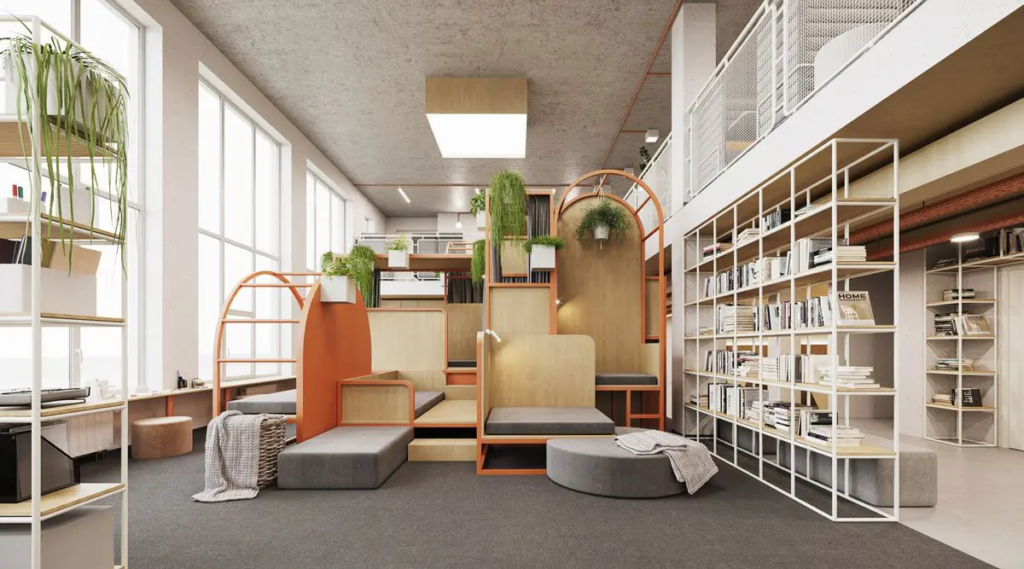
“Children should feel involved in all processes and be connected to the outside world,” believes Anastasia Kyreeva.
At the entrance to the building, there will be a reception area where one can see who is entering the premises. Nearby, there will be a small office for handling financial matters, and a medical room where children can receive first aid and, if necessary, contact their parents.
Laboratory/Greenhouse and Gym/Concert Hall
To create a better connection with the natural environment, the school project initially included a rooftop greenhouse. There, children were supposed to grow the food they would consume. The greenhouse was to feature a large glass dome, which would incur significant costs. As a result, the idea was eventually abandoned due to the excessive expenses.
The greenhouse space has been replaced with a research laboratory. Here, three fields will intersect — academic sciences, artistic practices, and engineering research.
The gym in the school will be small and versatile. Changes in ceiling levels have created additional opportunities for balconies above. The gym will have direct access to the outdoors, providing extra opportunities for activities during the warmer months.
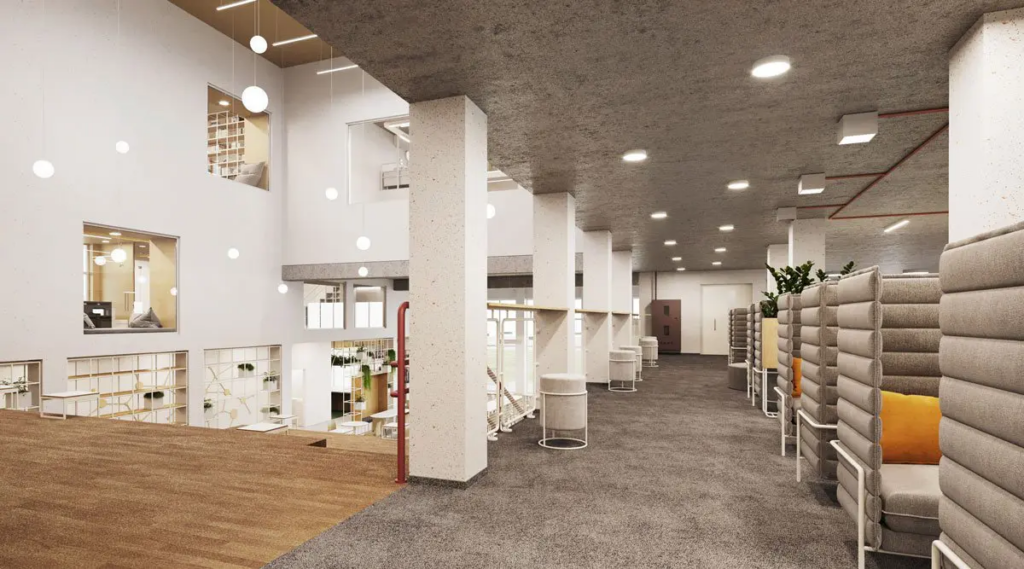
Additionally, the gym can easily transform into a sort of concert hall with a curtain and dressing room. Everything is designed so that, for example, guests of the complex can enter through a separate entrance to attend a school theater performance.
To manage the visual and sound aspects, there is a sound engineer’s room, which, during regular school hours, serves as a learning studio with professional equipment.
Kindergarten
For the kindergarten project, a key principle was providing quick access to the street for the children. However, current regulations require that group rooms must have two separate spaces — one for play and one for sleeping. This led to the idea of two-story group areas. Upstairs is the space for sleeping, and downstairs is for play and activities with an exit to the street.
The kindergarten also includes social stairs connecting two groups, creating additional opportunities for play. On the second floor, there is a multifunctional (gymnastics, dance, concert) hall.
A multi-story play labyrinth is planned for the kindergarten. On weekends, this space will be accessible to children from outside. Nearby, there will be areas for speech therapy sessions and a space for group activities, open to everyone interested.
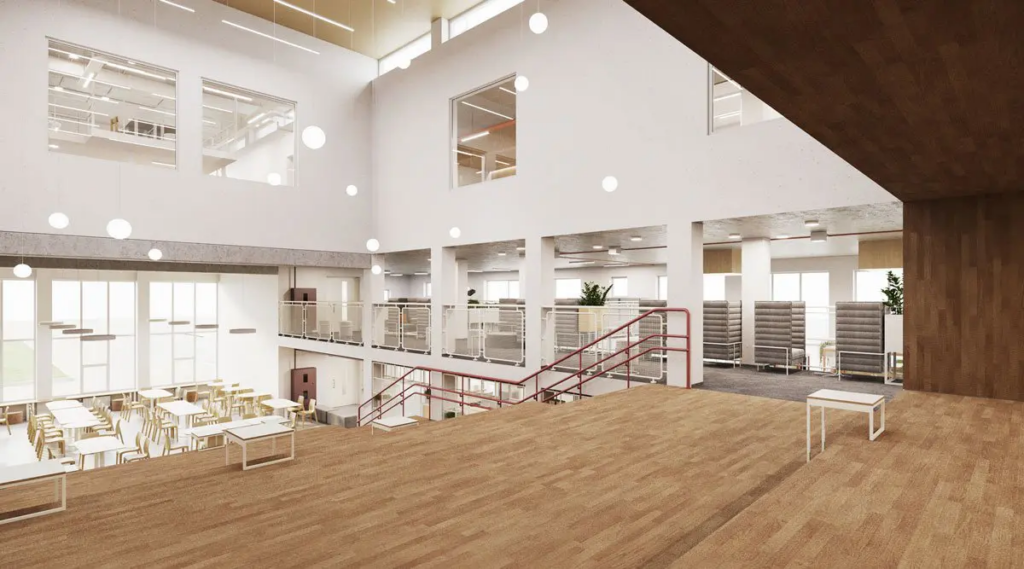
A small lobby will serve as a comfortable waiting area for the parents of preschool children.
Exterior: Naturalness and Simplicity
The interior of the school will use minimal materials — concrete, painted surfaces, wood, and glass — with almost no decorative finishes. The “house” and corridors, where children will spend most of their time, will be beige.
The building’s exterior will also be quite minimalist. The architects aimed to create a sense of an “oasis of life” among the high-rise buildings of the newly built residential complex around it, where mature trees will only grow in “several” years.
“Painting the building in a bright color seemed too mundane. Creating external landscaping would be too expensive and inappropriate for our harsh climate,” explains Natalia Holub.
According to the designer, naturalness, wildness, and simplicity are the prevailing trends in modern landscape architecture. People are tired of neatly trimmed textures and prefer natural forms.
This led to the idea of creating a metallic support on the building’s facade, around which decorative ivy-like grapevines, resembling ivy with triangular leaves, will grow. The plant will gradually cover the entire support, changing its color depending on the season. The self-sustaining mesh construction system was designed by Alexander Maymeskul. Before planting the grapevines, the support will be painted in a rusty color.

“This facade becomes a kind of metaphor for the school’s concept. The grapevine can grow for a long time, wither, and then recover. Everything needs time to grow. Similarly, a child needs time and space to express themselves — at their own pace, in their own way, and in a form that feels natural to them. Our attempts to push the child in a certain direction may result in their initial intentions being nullified,” notes Anastasia Kyreeva.
The landscape design of the school will also closely resemble a natural environment — with many trees, greenery, different types of paving, and playgrounds. This is an environment where a child can imagine they are in the jungle or a fairy-tale world.
It is important to note that the company “Exquisite Gardening,” inspired by the ideas and approaches of “Spilnoschool,” developed the landscape design free of charge.
The division between play areas will be quite conditional. A traditional amphitheater will be provided for the children, where they can watch sports games, relax, or read a book. There will also be a water play area and a tunnel inside the slide.
For landscaping, plants adapted to our climate and that retain their decorative value throughout the year were chosen. Overall, the space design aims to encourage children to spend more time outdoors, respect live communication, and be part of the changes in the country.
